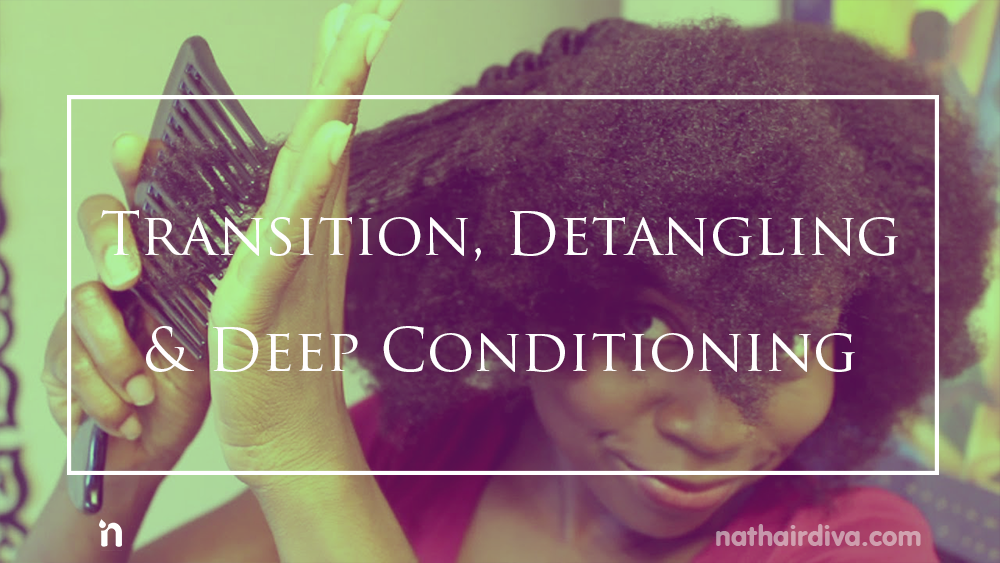Welcome to another educative session on Natural Hair Care 101. Today we will be tackling three topics (Transitioning, Deep Conditioning and Detangling)you might be thinking “Haba why three at once? Is it not too much?” This is because these concepts are very simple and easy to understand once they are properly explained.
Quick Access
Transitioning
Not everyone wants to start their natural hair journey with a bald head or big chop. Some people with damaged or relaxed hair choose to go do a big chop (cut off a large chunk of your hair) to start from scratch but for those who don’t want to go that part and want to start their natural hair journey with long hair on their head, they choose to transition instead.
What is transitioning?
Transitioning in natural hair refers to the process of growing out your natural hair before cutting off the damaged or relaxed hair ends. During this process, you are to stop using relaxer and any other hair damaging products. Since this is most likely the first step into the natural hair journey, it is best to not be in a rush to try out all the natural hair care products you have seen in the market. The most important thing to do during transitioning is patient with your hair. It needs time, care and love to grow.
Deep Conditioning
Whether you are transitioning or your hair is all-natural, Deep Conditioning is very important and should be part of your regimen. Deep Conditioning simply refers to the process of applying moisturizers or protein-based conditioner to the hair.
We have talked about the hair needing protein to grow and the need to moisturize your hair, Deep Conditioning your hair can help in both areas and it also strengthens your hair and keeps it healthy. There are different kind of deep conditioners you can choose from. We have the DIY conditioners, store-bought conditioners, and a mix of both ( which is adding additional ingredients to a store-bought conditioner.

How to Apply Deep Conditioner on your Hair?
Simply apply the product gently from the ends of your hair to your scalp. It is beneficial to also start massaging the product into the hair at the ends of the hair as that’s where you find old hair strands that easily break off.
When to deep condition your hair?
Some sisters decide that its best to deep condition your hair before using shampoo, while some feel it should be after using a shampoo. However, both methods are fine, however deep conditioning your hair immediately after shampooing your hair doubles the effect of the deep condition treatment. So you might decide to do it after shampooing for maximum results.
Additional ingredients to store-bought conditioners
You can add oil such as coconut oil or olive oil to increase their conditioners moisturizing ability. Regarding what sort of deep condition product to, simply go for the product that gives your hair the most suitable results.
How you should deep condition.
Regarding how often you should deep condition, I say do what works best for your hair, try deep conditioning once a week for at least two months and monitor your hair growth, try switching to deep conditioning every two weeks for some months also monitor how your hair responds then try deep conditioning once a month or longer than once a month and as usual check, the progress made with based on each routine and stick to the ones that is most suitable for your hair and have benefiting results.
DIY Conditioners
For DIY deep conditioners you can add coconut oil to a conditioner and use as a deep conditioner. Recipes of DIY deep conditioners and how to apply them would be tackled in an upcoming article. Concerning how long the deep conditioner is supposed to stay on the hair, read and follow the instructions on the product package or the DIY recipe. No specific time works because our hair type varies. My hair might require 30 minutes before the deep conditioner is deemed to have penetrated the necessary hair cuticles meanwhile your hair needs just 10 minutes so in all follow instructions and observe how your hair responds to the deep conditioner.
Deep Conditioning requires you to apply the product while it is warm, if your product is not DIY where you can easily warm the mixture you have created, you can either use a blow dryer to warm the product or apply the deep conditioner to your hair and use a heating cap. Remember to cover your hair with a shower cap while the deep conditioner sets in your hair. Once the deep conditioner has set in your hair for the specified number of minutes rinse it out and leave your hair to air dry.
Detangling

Detangling simply refers to removing tangles and knots in the hair. You can do this with your finger or a tail comb or detangler brush. It is easier to detangle wet hair as hair is usually more manageable when wet. If your hair is dry or coarse, massage or sprays natural oil into the hair before detangling. You can detangle your hair using conditioner also, you are not restricted to oil and water.
How to detangle your hair
Divide your hair into sections, the smaller the sections the easier it is to detangle.
First, detangle with your hands and start from the tips of your hair, gently separate knots and detangle.
After detangling that section with your fingers you can use a rat tail comb or detangler brush to comb the rest of tangles out.
Benefits of detangling
One problem people have is retaining hair. When you harshly comb out tangles and knots, it can lead to the hair breakage as the knots and tangles are forcefully combed out. Detangling reduces the amount of hair that is lost through combing.
Roughly stretching and combing can lead to damage of the hair cuticle and a damage hair cuticle will shed more and break off more which is contrary to what we want which is to retain hair.
If we can implement two of these tips into our hair routine we will have more healthy and longer hair.
Was this helpful? Kindly share with friends.
Was this helpful?

0

0


3 replies on “Transitioning, Deep Conditioning, and Detangling”
[…] Detangling your hair gently with a comb or with your hand instead of forcefully combing knots and tangles out will reduce the amount of hair you shed off. Finger combing reduces hair loss further. […]
[…] the Aloe vera gel for 15-30 minutes under a shower cap like any other conditioner and your result will be soft supple […]
[…] someone who likes to use natural ingredients on my hair, I struggled with finding deep conditioning hair products that had I liked. A lot of them had chemicals that I wasn’t sure about. So, I had […]